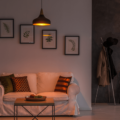It has been proven that LED lights can save all of us some money and reduce energy consumption around our homes and workplaces. But have you ever wondered why they have only become widely available in recent years when the first LED was invented over ninety years ago?
The answer may shed some light on the life-changing potential of LED lights, but to find it we first need to look at where LED light bulbs came from.
The First LED
It has been over a century since the English engineer H. J. Round first discovered the phenomenon of electroluminescence, a breakthrough that led directly to Oleg Losev’s invention of the first light-emitting diode (LED) in 1927.
Unlike traditional incandescent light bulbs, LED light bulbs don’t use a filament to produce their light. Instead, they are illuminated by the movement of electrons in a semiconductor material. It means that they can emit the same brightness as a traditional light bulb, but using only a fraction of the power. They also last many times longer than incandescent light bulbs, as there is no filament to burn out,[i] making them cost-effective and energy-efficient.
It is difficult to overstate the importance of this discovery and the impact it has had (and will continue to have) on our planet. It was several decades before the technology advanced enough to pass into everyday use, but their energy efficiency and low power requirements have since allowed LED light bulbs to be used in everything from calculators, watches and, more recently, light bulbs.
Early Uses
Initially, LED light bulbs were only used in specialist electronic and laboratory equipment, mainly because the light they produced was not appropriate for other uses. Also, the cost of manufacturing them was far too high to be commercially viable; early LED light bulbs could cost anywhere up to $200 per unit.[ii]
As research into LED technology continued, they became cheaper to produce and the quality of the light they emitted was improved. In 1962, an American engineer called Nick Holonyak created the first LED that produced visible light suitable for a wide variety of uses. From there, the technology boomed.
By the 1970s, companies were mass-producing LED light bulbs for as little as five cents each and everything from calculators, watches, radios and telephones would soon use some form of LED. It is the fundamental technology used in today’s large screen, ultra-high-definition televisions, as well as the next generation of domestic and commercial lighting.
Blue-light LED light bulbs
It is only in recent years that this sort of application has been made possible though. That’s because, for a long time after their invention, only red, green and yellow LED light bulbs could be made which, while suitable for many uses, were not appropriate for lighting our homes and workplaces.
It wasn’t until the 1990s that scientists Isamu Akasaki, Hiroshi Amano and Shuji Nakamura invented the blue-light LED and with it the ability to create white LED light (for without the full spectrum of light, white light is not possible). The feat was a revolutionary one[iii] and the three scientists were awarded the Nobel Prize for physics in 2014 for their achievement. Giving the prize, the Royal Swedish Academy of Sciences predicted that, “Incandescent light bulbs lit the 20th century; the 21st century will be lit by LED lamps.”[iv]
Where we are now
It was only a short hop from blue-light to white-light LED light bulbs, but from there the next challenge was to develop the technology for commercial use. Companies such as Philips dedicated resources to the development of LED lighting in the late 2000s, and by 2010 the technology started to pass into common use.
From there, the market for LED lights has grown considerably, as the cost of producing them has fallen and consumers have learnt of their benefits. In 2015, the estimated growth for LED lighting in the UK was 38%; the market is expected to continue to see double-digit growth up to 2020.
There is now a wide variety of LED light bulbs available, from tiny surgical lights to high-powered floodlights. They are even used as part of some ground-breaking cancer treatments.[v] As the development of technology advances, the cost and energy efficiency of the light bulbs will only continue to improve.
The Future of LED lights
The discovery of blue-light LED light bulbs unlocked the true potential of LED lighting, but so far we have only scratched the surface of the technology.
LED lights could change the lives of the 1.3 billion people around the world living without electricity.[vi] Combined with solar power, LED light bulbs could provide cheap, sustainable sources of light to places that don’t have an electric grid. Charities such as SolarAid have already started deploying solar lights to countries in sub-Saharan Africa, where 7 out of 10 people have no access to electricity.
The versatility of LED light bulbs means that their practical uses are countless. This article by Inhabitat describes some of the more innovative ways the technology could be utilised, including LED ‘Virtual Sky,’ which replaces traditional ceiling panels in workplaces with ‘light-laced modules’ that mimic the sky and increase worker productivity. Or how about LED wallpaper, which changes colour at the flick of a switch?
Todd Manegold, Head of Product Marketing, LED Lamps at Philips, predicts that LED lighting will soon allow consumers to integrate their lighting systems with other household devices, creating a fully ‘connected’ home. The lights could be linked to your entertainment network, where they respond to the beat of your music or the sound from your television. They could also react to your movements, switching on when you’re on your way home from work and switching off again when you leave the house.[vii]
The potential of LED technology is only limited by our imagination. For many years LED light bulbs were mainly used as ‘indicators’ (such as power lights on electronic devices). Blue-light LED light bulbs changed all that and now LED lighting is used almost everywhere. It may still be some time before we realise the full potential of LED lights, but they have already come a long way from that first humble diode.
[i] How Stuff Works – How Light Emitting Diodes (LEDs) Work
[ii] Wikipedia – Light-emitting diode
[iii] UCL Mathematical & Physical Sciences – Shedding light on why blue LEDs are so tricky to make
[iv] The Grocer – The LED evolution: Colourful story of the light-emitting diode
[v] Cancer.org – What is photodynamic therapy?
[vi] Washington Post – Without electricity, 1.3 billion are living in the dark
[vii] Forbes – Philips And The Future Of LED Lighting





hey led lights were created by Shuji Nakamura